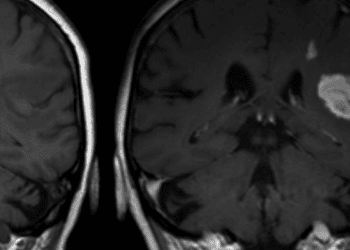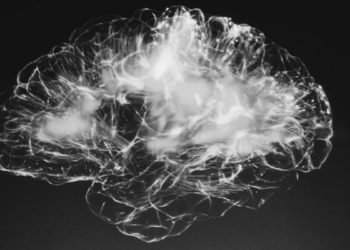Serum glial fibrillary acidic protein levels may be helpful to aid diagnosis of sports related head injuries
1. Glial fibrillary acidic protein (GFAP) levels peak around 24 hours after traumatic brain injury (TBI)
2. Higher GFAP levels were correlated with earlier sampling time
3. GFAP levels were not correlated with subjective concussion symptom severity
4. Combining GFAP levels and Sport Concussion Assessment Tool (SCAT5) improved the diagnostic accuracy of sport-related concussion
5. Neurofilament light (NfL) levels were not useful in the diagnosis of sport-related concussion
Evidence Rating Level: 2 (Good)
Study Rundown: Sport-related concussion (SRC) is a common mild traumatic brain injury (TBI) in contact sports, yet its diagnosis remains challenging due to reliance on subjective symptom reporting. This study investigated the diagnostic utility of glial fibrillary acidic protein (GFAP) as a biomarker for SRC, hypothesizing that GFAP peaks around 24 hours post-injury. A prospective cohort study of 151 concussed and 97 control athletes measured GFAP and neurofilament light (NfL) levels at 16–24, 24–32, and 36–52 hours post-injury. Results showed that GFAP was significantly elevated in SRC cases at 16–24 hours (median: 124.6 pg/mL vs. 65.9 pg/mL in controls) and demonstrated strong diagnostic accuracy (AUC = 0.83). GFAP levels declined over time, with reduced utility beyond 32 hours. Combining GFAP with SCAT5 symptom assessments improved diagnostic performance (AUC increased from 0.91 to 0.97). In contrast, NfL was not useful for acute SRC diagnosis. These findings suggest that next-day GFAP measurement provides a reliable, objective diagnostic tool for SRC, particularly when combined with symptom assessment. Implementing GFAP testing into clinical practice could enhance diagnostic accuracy, reduce reliance on subjective symptom reporting, and support safer return-to-play decisions, with further research needed for broader validation.
Click to read the study in Neurology
Relevant Reading: Consensus statement on concussion in sport
In-Depth [prospective cohort study]: Sport-related concussion (SRC) is a common mild traumatic brain injury (TBI) that occurs in contact sports such as football, rugby, and hockey. Diagnosing SRC remains challenging due to its reliance on subjective symptom reporting, which can be incomplete or biased by an athlete’s desire to return to play. An objective, biomarker-based test could enhance diagnostic accuracy and ensure safer return-to-play decisions. Glial fibrillary acidic protein (GFAP), an astrocytic injury marker, has emerged as a promising blood-based biomarker for TBI. Research suggests that GFAP levels peak approximately 24 hours post-injury, but previous studies may have failed to capture this peak, potentially underestimating its diagnostic utility. This prospective cohort study aimed to evaluate the diagnostic performance of serum GFAP at 24 hours post-SRC, assess the impact of sample timing on GFAP levels, determine whether combining GFAP with symptom severity improves diagnostic accuracy, and investigate the diagnostic utility of neurofilament light (NfL) in the acute phase of SRC. Blood samples from 151 Australian football players diagnosed with SRC and 97 control athletes without SRC were collected at three post-injury time intervals: 16–24 hours, 24–32 hours, and 36–52 hours. GFAP and NfL levels were quantified using Simoa assays, while symptom severity was assessed using the Sport Concussion Assessment Tool (SCAT5). The diagnostic utility of GFAP and NfL was analyzed using area under the curve (AUC) values, with comparisons between groups and across time points. Serum GFAP levels were significantly elevated in SRC athletes compared to controls, particularly at 16–24 hours post-injury (median: 124.6 pg/mL vs. 65.9 pg/mL in controls). GFAP levels declined progressively over time, with lower values observed at 24–32 hours and 36–52 hours, reinforcing the hypothesis that GFAP peaks around 24 hours post-injury. At 16–24 hours, GFAP demonstrated strong diagnostic accuracy with an AUC of 0.83, decreasing to 0.72 at 24–32 hours. By 36–52 hours, GFAP levels were no longer useful for distinguishing SRC cases from controls. The study also examined how combining GFAP levels with SCAT5 symptom scores affected diagnostic performance. At 16–24 hours, integrating GFAP with symptom severity significantly improved classification accuracy, increasing the AUC from 0.91 (SCAT5 alone) to 0.97. This indicates that biomarker testing can provide an added layer of objectivity to standard clinical assessments, reducing the risk of misdiagnosis. In contrast, serum NfL levels were not significantly elevated in the acute phase of SRC and did not differentiate SRC cases from controls (AUC ≤0.60). This suggests that while NfL may be valuable for tracking long-term neuroaxonal damage, it does not provide reliable diagnostic utility in the first 24–48 hours post-injury. The study also identified a significant correlation between GFAP levels and time to sample collection post-SRC, with higher GFAP concentrations associated with earlier sampling times. This finding underscores the importance of timely biomarker measurement to maximize diagnostic accuracy. Furthermore, while GFAP levels correlated with SRC presence, they did not correlate with symptom severity, suggesting that GFAP reflects an underlying physiological response rather than an athlete’s subjective experience of symptoms. Next-day serum GFAP measurement is a valuable and objective tool for diagnosing SRC. Its ability to distinguish concussed athletes from controls with high accuracy within 16–24 hours post-injury supports its clinical utility as an adjunct to symptom-based assessments. Given the limitations of self-reported symptoms, incorporating GFAP testing into SRC management protocols may improve diagnostic confidence and optimize return-to-play decisions. Further studies are needed to validate these findings across diverse sporting populations and settings to ensure the widespread applicability of GFAP as a diagnostic biomarker for SRC.
Image: PD
©2025 2 Minute Medicine, Inc. All rights reserved. No works may be reproduced without expressed written consent from 2 Minute Medicine, Inc. Inquire about licensing here. No article should be construed as medical advice and is not intended as such by the authors or by 2 Minute Medicine, Inc.







